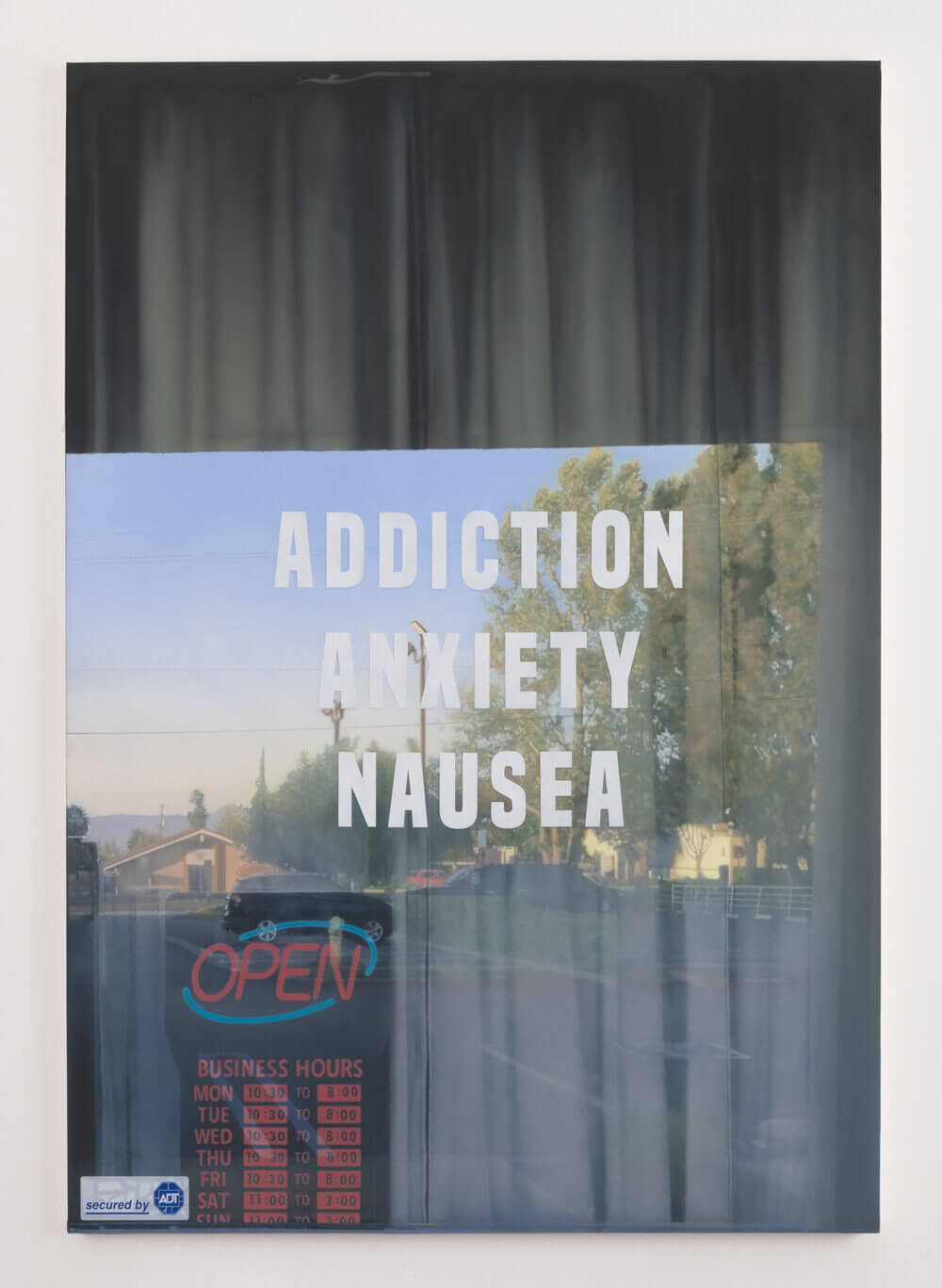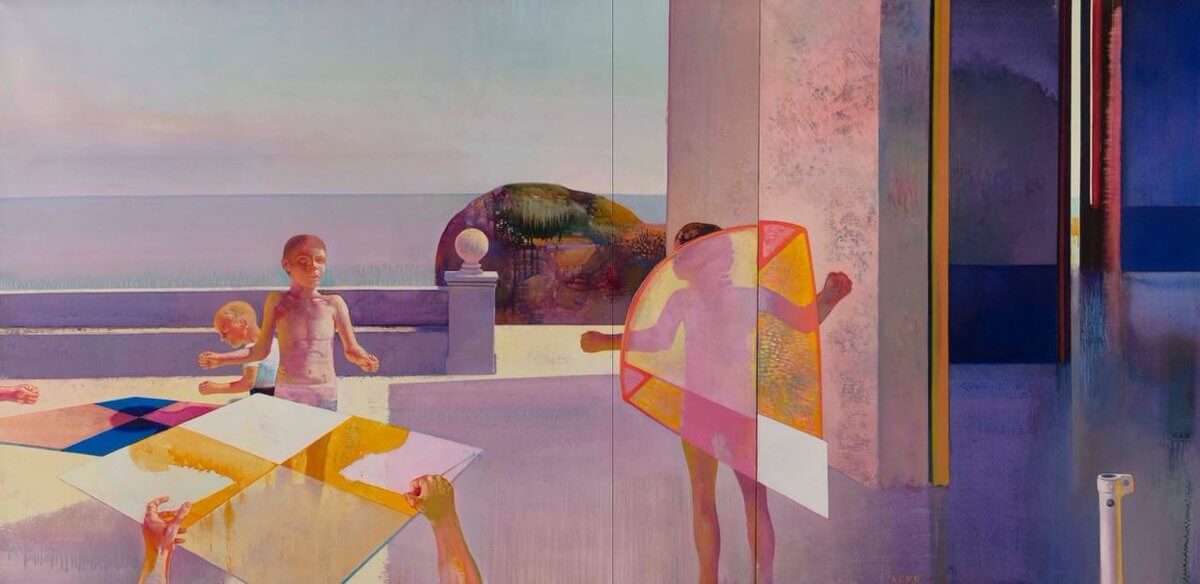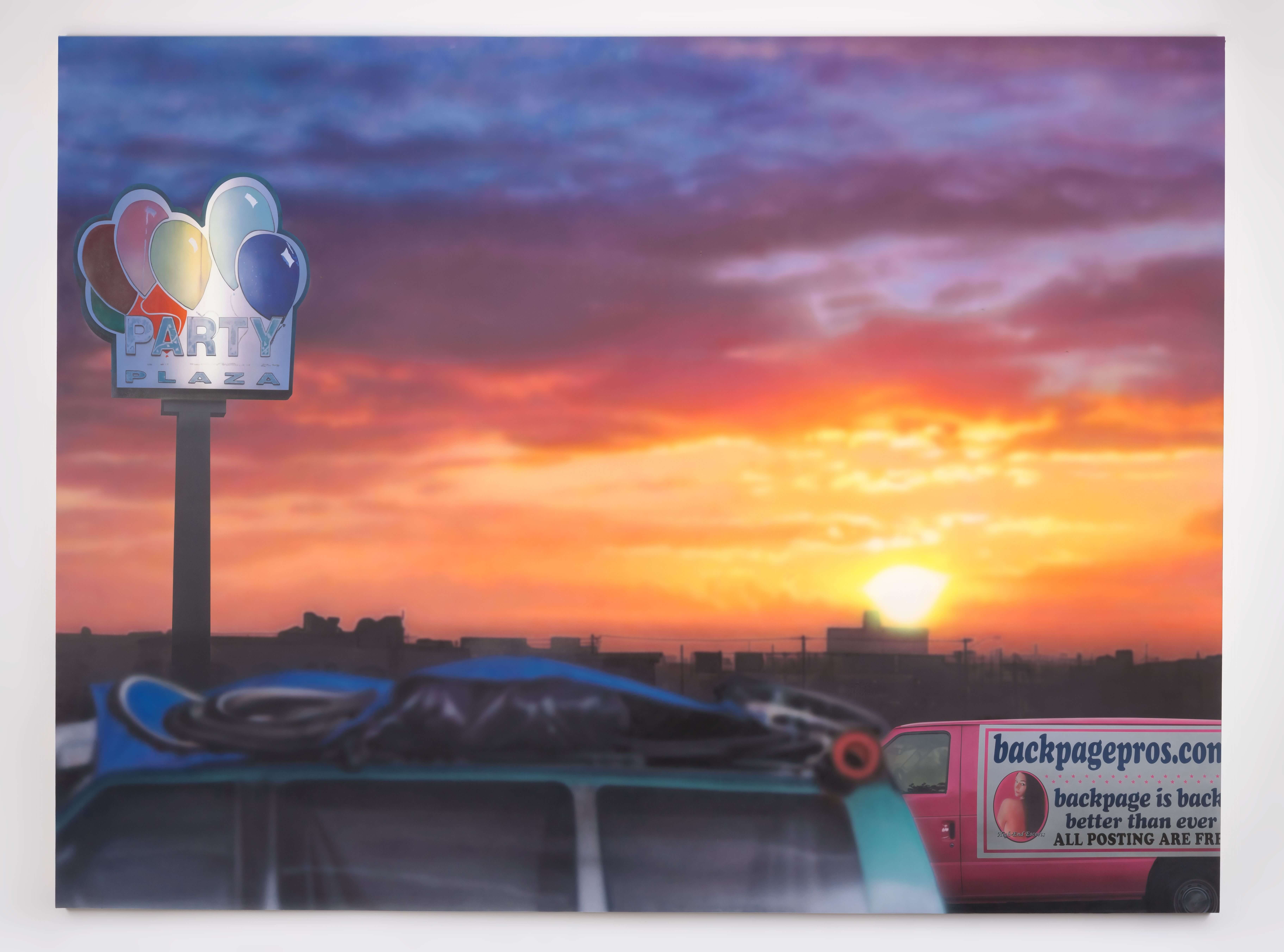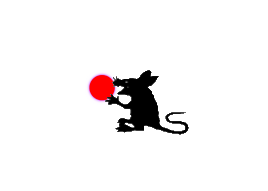Daniel Spaulding
Sayre Gomez:
Hilarity Ensues

I had an art historian’s reaction the first time I encountered Sayre Gomez’s paintings: These look too much like movies. This is an odd thing to complain about. It also happens to be a case of what art historians, following Erwin Panofsky, call “pseudomorphism,” or false resemblance—because the more I thought about them, the less the paintings looked like any specific movies I could think of. Their movie-ness is a function of their Los Angeles-ness. Gomez’s cityscapes are impossible to mistake for anywhere else. Yet it’s a Los Angeles that neither filmmakers nor artists very often depict in this particularity: forlorn stretches of sidewalk and shopping plaza; freeway shoulders; homeless encampments, the latter usually blurred or otherwise at the edge of discernability, perhaps in resistance to what Martha Rosler once called the “find-a-bum” school of social documentary. The documentary impulse is still there in other ways. Everything Gomez paints is based on something seen. After prospecting the city for imagery (there’s a weirdly satisfying video of the artist cruising LA’s proletarian Downtown and Eastside), he then works up the separate pictorial elements in the vector graphics program Illustrator. Digitized tidbits turn into extravagantly precise stencils that Gomez uses to build each image piece-by-piece, in a process that somewhat recalls the old cell animation techniques that Walt Disney and his contemporaries perfected. Finally he reverses the course of media supersession by going from pixel to airbrush. Gomez takes this high-gloss sheen to sites that are usually devalued, or scarred, by the retreat of capital, even as almost everything in them is of capital’s making. Even the picture-perfect sunsets are as if borrowed from some yet-larger billboard. Billboards proper, or usually more modest signs, tend to show up exactly parallel to and pressed against the picture plane, in deference to the trompe-l’oeil tradition.
These paintings are attuned to surface effects. In Building in Deconstruction with Chain Link and Ivy, 2017, [fig. 2] a highly formalized fence impedes our view of a structure in the process of being knocked down. Most likely a boxy condo will go up in its place. (Gentrification is a frequent concern in the artist’s work.) The same stencil reappears in Angelina Hosiery with Chain Link and Ivy, 2017 [fig. 3], in which the occluded image is an advertisement for off-brand lingerie. Once Gomez repeats a pattern, it becomes evident that the motif functions in a more abstract or decorative fashion than might have first appeared. It almost becomes an allover.
These paintings are attuned to surface effects. In Building in Deconstruction with Chain Link and Ivy, 2017, [fig. 2] a highly formalized fence impedes our view of a structure in the process of being knocked down. Most likely a boxy condo will go up in its place. (Gentrification is a frequent concern in the artist’s work.) The same stencil reappears in Angelina Hosiery with Chain Link and Ivy, 2017 [fig. 3], in which the occluded image is an advertisement for off-brand lingerie. Once Gomez repeats a pattern, it becomes evident that the motif functions in a more abstract or decorative fashion than might have first appeared. It almost becomes an allover.

Repetition is one of several formal devices that militate against the reception of this art as photorealist in a straightforward way. Another is soft focus, a photographic tic that Gomez mobilizes as a discrete element within his painterly montage. The characteristic device in these works is the use of literal or implied scrims to produce layers of spatiality distinguished by their degree of focus: too-sharp distinction for certain layers, too-fuzzy dispersion for others. Sometimes the layers are wholly analogized to the effect of a camera’s f-stop; sometimes they have a more surreal (that is, un-cameralike) sharpness; sometimes, a notional object in the representation acts as an interference pattern, as with the staggeringly detailed bug screen in CRY: The Sequel, 2021 [fig. 4]. Motifs such as the latter thus (literally) blur the difference between optical effect and near-indexical imprint, as if to short-circuit imitation of the look of photography (or film) with photography’s (or film’s) ontology.[1] Elsewhere the pictures open onto what are nearly classical landscape panoramas apart from their dire modernity.


Planes that signal transitions from one social zone to another are often visually permeable membranes, like the abovementioned chain-link fences, which are a literal marker of property lines. One of the curious things about these membranes is that, although in pictures such as Untitled, 2019 [fig. 5], we seemingly view them from the side of the street, or from public space, the other side often appears to be publicly accessible, too—at least nominally, or, to put a finer point on it, accessible in a differentiated and limited mode that makes doubtful the universality of “publicness” as such. A fence at the perimeter of a shopping plaza doesn’t keep anyone out, since of course you can just walk around it. The point is to restrict the movement bodies to vectors that pose a minimal threat to property. Gomez’s scrims reflexively formalize this osmotic filtration of social space.
It’s because his work is so useful in parsing the real yet arbitrary violence of property that Gomez’s “realism” is not exclusively of a retinal variety; is not a realism of how things look to the innocent eye so much as a realism of relations (between haves and have-nots; between inside and outside; between objects as they occupy space and time and their ghostly doubling in “commodity” or “law”). Gomez is a painter of Los Angeles in the way Louis Althusser described the (now mostly forgotten) 20th century Italian painter Leonardo Cremonini as a “painter of the abstract,” even though Cremonini’s work is figurative [fig. 6]:
It’s because his work is so useful in parsing the real yet arbitrary violence of property that Gomez’s “realism” is not exclusively of a retinal variety; is not a realism of how things look to the innocent eye so much as a realism of relations (between haves and have-nots; between inside and outside; between objects as they occupy space and time and their ghostly doubling in “commodity” or “law”). Gomez is a painter of Los Angeles in the way Louis Althusser described the (now mostly forgotten) 20th century Italian painter Leonardo Cremonini as a “painter of the abstract,” even though Cremonini’s work is figurative [fig. 6]:
In order to 'see' Cremonini, and above all to talk about what he makes visible, we have to abandon the categories of the aesthetics of consumption: the gaze we need is different from that of desire for or disgust with 'objects'. Indeed, his whole strength as a figurative painter lies in the fact that he does not 'paint' 'objects' (those dismembered sheep; those tortured carcasses; that stone; those plants; that 1900 armchair), nor 'places' (the sea, seen from the heavy articulated skeleton of an island; seen from a window open to the air; that balcony hanging in the sky; those rooms with polished wardrobes and beds; that dubious washroom; that compartment on a night train), nor 'times' or 'moments' (the morning at dawn; the night, high noon in a courtyard drenched in sunshine where little girls play hop-scotch). Cremonini 'paints' the relations which bind the objects, places and times. Cremonini is a painter of abstraction. Not an abstract painter, 'painting' an absent, pure possibility in a new form and matter, but a painter of the real abstract, 'painting' in a sense we have to define, real relations (as relations they are necessarily abstract ) between 'men' and their 'things', or rather, to give the term its stronger sense, between 'things' and their 'men'.[2]


It’s useful to test the above against Gomez’s large 2020 painting The Party Continues [fig. 7]. The artist here borrows Ed Ruscha’s automobile-enabled scanning vision of Los Angeles while turning it more pointedly to racialized class distinctions and forms of labor that Ruscha’s deadpan tends to occlude: in this case sex work, in an advertisement for what is, evidently, a dubiously-legitimate successor to the online advertising service Backpage, shut down by federal authorities in 2018. In the foreground a blurred-out vehicle seems to be hauling scrap on its roof, in a contemporary version of Millet’s Gleaners. Above the horizon a down-at-the-heels party store sign and an ominous sunset round out the scene.
Ruscha incarnates a certain 1960s idea of what “realism” might mean: reality as one-thing-after-another, depiction effectively formless absent the arbitrary form of the parameter itself. It could be said that Ruscha’s photobooks are what happens when art stops pretending it can inject anecdote into modernity and decides instead to eliminate it ruthlessly. Gomez on the other hand attempts a painting of modern life. This leaves his work vulnerable to what one might call, minimally, trope, and maximally, ideology or myth. Certainly myth is one of his materials—including the myth that has grown up around Ruscha, ironically, as the latter’s deadpan accumulates a glamor of its own. But class, race, and hardship are Gomez’s materials, too, even if human figures are usually only present as representations of representations. In this view, LA is a city of reified surfaces that are not merely the sheen over LaLa Land’s squalor, à la Sunset Boulevard and the other great monuments of Sunshine Noir. Surfaces themselves are agents and vehicles of squalor.
This is how I’d define spectacle.[3] This is spectacle at ground level. It doesn’t much resemble utopia. The Party Plaza sign is a parody of fun sold back to us. But then, parties with balloons are more fun, and within the universal alienation of sociality who’s to say that Party Plaza might not be fun’s best or at least most authentic purveyor? The institution called the American party store is a source of image-commodities come home to roost in the negative affect of late capitalism. These days, there are few other places where clown paraphernalia might be encountered, apart from horror films, which makes it all the more depressing. Comforts such as these glow with dark nostalgia, like the dulcet tones of a Soundcloud rapper. We know that realism often achieves its highest intensity when its gaze turns to the outmoded.
Window, 2020 [fig. 1], uses another screen-device to cue the viewer’s depressive position. The fact that this is not WebMD and this is not a smartphone but rather a physical window (touting what might as easily be hypnotherapy or psychic readings as low-rent psychoanalysis) goes some way towards desublimating our meme-like state of always feeling terrible. After all, most people just go about their business that way, picking up treatment where they can: a round of tarot or some pills. Either way, ADT Security is down there at lower left to ensure that what really matters—property—remains intact. La lutte continue, the party continues.
This is slow spectacle. It’s not all that spectacular. Star Wars usually gets credit for popularizing the idea of a “used future,” that is, janky spaceships, malfunctioning robots and so on. But if capital is always oriented towards the realization of future profit at the cost of present and future human and nonhuman wellbeing, then our used future is now. Spectacle is not so much images as sociality turned into images that act like commodities.[4] And commodities are above all disposable, since they only serve as a means to something else (capital accumulation). A smiley face in a trash can [fig. 8] returns flat neoliberal affect to the dustbin of history from whence no doubt it will leach toxins into air and groundwater for centuries (millennia?) to come. In this picture, as in some of Gomez’s others, you can also literally watch paint peel.
Ruscha incarnates a certain 1960s idea of what “realism” might mean: reality as one-thing-after-another, depiction effectively formless absent the arbitrary form of the parameter itself. It could be said that Ruscha’s photobooks are what happens when art stops pretending it can inject anecdote into modernity and decides instead to eliminate it ruthlessly. Gomez on the other hand attempts a painting of modern life. This leaves his work vulnerable to what one might call, minimally, trope, and maximally, ideology or myth. Certainly myth is one of his materials—including the myth that has grown up around Ruscha, ironically, as the latter’s deadpan accumulates a glamor of its own. But class, race, and hardship are Gomez’s materials, too, even if human figures are usually only present as representations of representations. In this view, LA is a city of reified surfaces that are not merely the sheen over LaLa Land’s squalor, à la Sunset Boulevard and the other great monuments of Sunshine Noir. Surfaces themselves are agents and vehicles of squalor.
This is how I’d define spectacle.[3] This is spectacle at ground level. It doesn’t much resemble utopia. The Party Plaza sign is a parody of fun sold back to us. But then, parties with balloons are more fun, and within the universal alienation of sociality who’s to say that Party Plaza might not be fun’s best or at least most authentic purveyor? The institution called the American party store is a source of image-commodities come home to roost in the negative affect of late capitalism. These days, there are few other places where clown paraphernalia might be encountered, apart from horror films, which makes it all the more depressing. Comforts such as these glow with dark nostalgia, like the dulcet tones of a Soundcloud rapper. We know that realism often achieves its highest intensity when its gaze turns to the outmoded.
Window, 2020 [fig. 1], uses another screen-device to cue the viewer’s depressive position. The fact that this is not WebMD and this is not a smartphone but rather a physical window (touting what might as easily be hypnotherapy or psychic readings as low-rent psychoanalysis) goes some way towards desublimating our meme-like state of always feeling terrible. After all, most people just go about their business that way, picking up treatment where they can: a round of tarot or some pills. Either way, ADT Security is down there at lower left to ensure that what really matters—property—remains intact. La lutte continue, the party continues.
This is slow spectacle. It’s not all that spectacular. Star Wars usually gets credit for popularizing the idea of a “used future,” that is, janky spaceships, malfunctioning robots and so on. But if capital is always oriented towards the realization of future profit at the cost of present and future human and nonhuman wellbeing, then our used future is now. Spectacle is not so much images as sociality turned into images that act like commodities.[4] And commodities are above all disposable, since they only serve as a means to something else (capital accumulation). A smiley face in a trash can [fig. 8] returns flat neoliberal affect to the dustbin of history from whence no doubt it will leach toxins into air and groundwater for centuries (millennia?) to come. In this picture, as in some of Gomez’s others, you can also literally watch paint peel.

It isn’t too often that anyone depicts this slow normal shittiness. In an interview with John Akomfrah in the first issue of Caligari, Devika Girish rightly pushes back against “the idea that time has ‘stilled’ during the global pandemic”—“what we’ve all experienced in these months is not so much a stoppage of time as an eruption of various temporalities that seem asynchronous with the churn of modern capitalist life.” True, but capitalism is asynchronous as such, in its uneven and combined development; in the grind of capital’s rhythms against human and ecological rhythms.[5] In its ideological function you could call “modernity” the illusion of synchrony. At ground level time is never thus. Old regimes always persist. There is, as I’ve briefly implied, a retrograde aspect to Gomez’s translation from digital back to analog, from Photoshop to airbrush. It’s a temporal loop that perhaps reflexively doubles (or is doubled in) the spectacle/slowness dyad that structures much of his imagery. We can observe similar things happening in reality itself. As life arguably slowed last year, the metabolism of disasters-as-image-events and image-events-as-disasters sped up. There was an uptick in spectacle. And yet things went on: rust rusted, fires raged (both are speeds of the same process, namely oxidation; so is life), hilarity ensued. It is not ever quite right to say that a painting is “about” something but I do think Gomez’s highly Instagram-friendly work has to do with a disjunctive synthesis of hyperfast image-circulation with the slower temporalities of corrosion, erosion, decay, weather, smog, combustion, aging, mutation, waste, immiseration—with humans (not fair: capital) as terrible accelerant.
[1] By which I mean the sense, widespread in the literature on photography, that a photograph is a direct trace of what it represents, like a shadow or a footprint, and thus constitutes an “indexical” sign (in the terminology of Charles Sanders Peirce).
[2] Louis Althusser, "Cremonini, Painter of the Abstract," in Lenin and Philosophy and Other Essays, trans. Ben Brewster (New York: Monthly Review Press, 1971), 157-158.
[3] It’s not remembered often enough how good Guy Debord actually was at talking about this. See, for example: “The spectacle originates in the loss of the unity of the world, and the gigantic expansion of the modern spectacle expresses the totality of this loss: the abstraction of all specific labor and the general abstraction of the entirety of production are perfectly rendered in the spectacle, whose mode of being concrete is precisely abstraction.” (Guy Debord, The Society of the Spectacle, paragraph 29; emphasis in the original.) Or: “The spectacle does not sing the praises of men and their weapons, but of commodities and their passions. In this blind struggle every commodity, pursuing its passion, unconsciously realizes something higher: the becoming-world of the commodity, which is also the becoming-commodity of the world. Thus, by means of a ruse of commodity logic, what’s specific in the commodity wears itself out in the fight while the commodity-form moves towards its absolute realization.” (Ibid., paragraph 66; emphasis in the original.)
[4] This is an adaptation of Debord: “The spectacle is not a collection of images, but a social relation among people, mediated by images.”
[5] In a more technical figure, certain writers (relying on Marx’s reference to a Zwickmühle or “double mill” in chapter 23 of Capital, vol. 1) have hit upon the useful image of two intersecting wheels: that of the reproduction of capital, and that of reproduction of labor power (the reproduction of workers). The production process occurs between the point at which the two circles meet (when capital purchases labor power) and the point at which they part again (when the working day ends and workers go off to purchase means of consumption). In a crisis of social reproduction, the two wheels careen off from each other; this is what has happened to the people living in Gomez’s homeless camps, since most of them, at least, are no longer reliant on wage labor for survival. An illustration of the double mill can be found in the “Afterword” to the first issue of the journal Endnotes. Gomez adds another factor: the rhythms of an impure “natural”/human ecology, such as the setting of the sun through Southern California’s smoke and smog-choked air, or corrosion on old metal.
Daniel Spaulding is Assistant Professor of Modern and Contemporary Art at the University of Wisconsin - Madison. He is a founding editor of Selva: A Journal of the History of Art.
